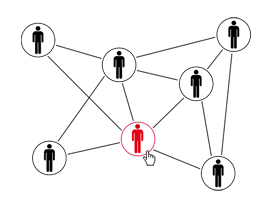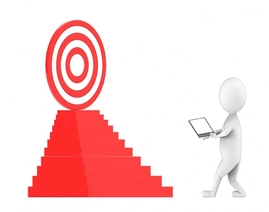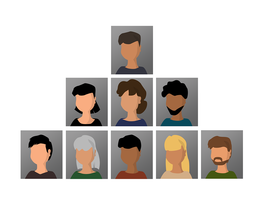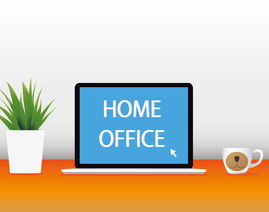The 6 'HABITS' of highly successful “Assistants”
No matter what your title, it is most definitely how you think, what you say and your behaviour that really matters!
To be a successful Assistant, learn and practice the following HABITS:
H is for habit
We all have certain habits that relate not only to our personal life and to our work life as well as this is the way our brains save energy. We work on our habits and rituals and routines via our subconscious mind 90-95% of the time and therefore we need to make sure we have the most efficient and effective habits that are the most productive, keep you positive and help you be successful rather than consistently repeating the habits that hinder your success.
You may have heard it takes 21 days to change a habit well that is nonsense. It takes each person the time it takes them, whatever that is, which could be a day, a week, 6 months or even a year but what you have to be, is tenacious and passionate about changing a habit and eventually, sooner or later it will happen for you.
A habit is triggered by a particular cue, situation or event therefore in order to break the habit be self-aware and notice the trigger for your unwanted habit. You could eliminate your trigger and then consciously and mindfully keep on repeating your new desired behaviour until it becomes the norm realising it will take as long as it takes so you know that you should never give up.
A is for Attitude
Your attitude to your work, your colleagues and even your life will determine whether you are successful or not!
We are all naturally negative (whether you are an optimist or a pessimist) as our brains are simply looking for whatever may be a threat to our survival and this includes real or perceived ‘threats’. A threat could simply be your boss shouting your name in an aggressive way and asking you to get into their office immediately. When this happens our brains decide that we either want to flee, fight, freeze or flock to our friends and talk about it. We need to change our negative thinking into positive thinking in order to enable our thinking, logical, rational part of the brain to kick back in.
Here are some quick and simple things you can do:
Change a negative word into a positive word whether you are saying it to yourself internally or speaking to others for example, if you are feeling nervous change it to say “I am feeling excited”, if you are feeling tense change it to say “I am feeling alert” – when you say positive things to yourself you will feel the change in your attitude and your resulting behaviour will be more productive.
Think about positive and happy memories and that could be about a place you love to visit or people that make your heart melt or make you smile.
Listen to cheerful music that makes your heart sing and your mind happy.
Simply put a smile on your face and look up to the ceiling because your brain listens to your body language and doing this makes your brain think you are happy whether you are or not and will start reducing your cortisol levels (the stress hormone).
Keep your confidence – no one can take this away from you unless you allow them to! Think positive and act positively, be a “will-do” “can-do” person and at the same time this means having the ability to be assertive and say what you need and want and have the ability and confidence to say ‘no’ when appropriate in order to get the important and urgent things completed and ticked off your ‘to-do’ list. Remember: every time you say no to something it really means you are saying yes to something else that you have prioritised – just make sure you are prioritising correctly and go with your convictions.
To keep your confidence you can also keep a “confidence file” where you can put all the ‘thank you’ and ‘well done’ emails that you receive. You can also write up your own notes of achievements such as costs you have reduced, time you have saved through creating a new system or anything you might want to bring up at your appraisal for improvements you have made. Take a look at your file whenever you are starting to feel negative and doubting yourself and change your mind back to being positive as you realise that you really are good and have done some excellent and worthwhile work.
Do what you say you are going to do – stop procrastinating when you know you should be doing something else that adds value at this moment-in-time – say to yourself: “Is this the best use of my time right now?” and “Am I adding value with what I am doing?”
Procrastination does have it’s place however, as your brain needs a break several times a day so you need to consciously give yourself a brain break which might mean doing tasks that require less thinking power like filing and making coffee and that may be the best use of your time at that moment.
Be aware of yourself, your thoughts, your actions at all times and when you realise you are being negative you need to take positive action to eliminate it and replace it with positivity.
B is for Behaviour
Behave the way you would like others to behave and set an example – be the leader of yourself, your boss and your family and behave in a way that others want to be like you. Be the person you want to be and not the person who develops through bad habits. You get what you focus on so focus on what you want and not on what you don’t want.
People only see 10% of you, which shows itself as your behaviour – they do not see the 90% made up of your values, thoughts, feelings etc so make sure that the behaviour you display is actually your intent and that you are perceived in the way you want others to see you. Self-awareness is one of the most important traits you can have because if you know how you are being perceived by others you may change your ways. How we perceive ourselves may not be the way others perceive us.
Ask people for honest and open feedback and show them you truly want to be the best person you can be and as a confident person you can take this helpful insight to change your habits to be the person you want others to see and know you as.
I is for Implement Sue France’s 25/75 rule:
We all have self-talk and sometimes it can lead to sabotaging yourself and you may say to yourself “I’ll leave that until later as it’s not happening until next week or next month” etc and then all of a sudden it’s here and you are not prepared. Events and meetings that are already on your calendar should not be allowed to sneak up on you! Many meetings need to be planned and booked well in advance, travel organised, cars ordered, printing sorted, people invited, agenda sent out and lots more. So all you need to do in order to be organised, create momentum and be prepared is to spend 25 minutes, two or three times a week, looking ahead over the next 75 days and preparing whatever it is you need for those upcoming trips, appointments and events which may even include diarising the next step of organising whatever it is that you have to do in the following week. Remember Sue France’s 25/75 Rule!
T is for Thinking patterns
Think in chunks – you brain performs best when you split your work up into chunks – for example organise to do your telephone calls in one chunk, organise to read and answer your emails in one chunk, organise to do your filing in one chunk, etc.
Think using your conscious, rational, logical, decision making mind and not just leaving it to your subconscious habitual mind in a routine way. We only use our conscious mind for 5-10% of the time because your brain uses up 20% of the energy you put into your body even though it is only 2% of your body mass. Therefore you need to make sure you eat nutritious, healthy foods and never skip breakfast or lunch. You also need to take regular ‘brain breaks’ in order to reboot your conscious mind as well as switch between hard and easy tasks.
Take a break and incubate - stop thinking about a problem when you have been stuck for 15 minutes
Have you ever thought of a solution when day dreaming? Have you ever been in the shower or driving along and something has come to your mind that you had no idea you were thinking about it? Have you ever woke up in the morning and know exactly what you need to do where as the night before you were worrying about it? Your subconscious mind works for you whilst you are not consciously thinking about something and even when you are asleep. So whenever you want to solve a problem a come up with a creative solution you can write your problem down on a whiteboard or type on to your schedule or jot it down in a notepad or dictate into your phone, so you feel secure in the fact that you know you won’t forget it and then tell your subconscious mind to work it out for you whilst you get on with something else. You can take a walk and get your lunch, tidy your desk area or do a different task and this even works at night before you go to sleep and when you wake up in the morning your mind will be much clearer and have ideas. Taking a break may be the best use of your time!
S is for Set a timer for 25 minutes
Spend 25 minutes on a task – this is the maximum amount of time your thinking, logical, decision making brain can work effectively. This is especially useful when facing a daunting and difficult task as once you begin a huge task even if it is a only the first chunk of it then the rest becomes much easier. After 25 minutes take a break or switch to an easy task that you don’t have to think hard about to give your conscious rational, logical and decision making part of your brain a rest and time to reboot. You only need a few minutes to reboot so you can do some filing, make a coffee, go for a walk etc.
One excellent use of your time would be to do a 3 minute mindfulness exercise which calms your brain down, helps to get rid of cortisol and allows you to start thinking rationally and logically again. Mindfulness is about being in the moment because you cannot control the past or the future but you can control the present! The more time you spend in the ‘present moment,’ the less time you spend on automatic pilot and therefore the more control you will have of a stress free life!
If you would like to download a free mindfulness exercise and other useful documents then visit my website www.suefrance.com and you will find many FREE downloads which are for my book “The Definitive Personal Assistant & Secretarial Handbook” 3rd edition all of which will help you to form the habits of a highly successful Assistant.
You May Also Like

The CMO of People
Many organizations are not getting the best out of their HR function. Ask a CEO, “What is your...

The Challenges of Hiring Future Ready Leaders and Russian Doll Theory of Hiring
One of the biggest challenges most companies face today is hiring transformational leadership talent...

Why Do Most Innovation Programmes Fail?
What do companies do when a new boss says “Innovation has to be part of our DNA”? Here ...

The Greatest Resource any Organization has is the Creativeness of People
For too many years people have been treated as expense items instead of highly valuable resources. T...

How To Quit A Job You Love
It is not easy to quit a job you love. Even with a new dream job in-hand, cutting the cord that conn...

Take on Mistakes
Yes, we do say mistakes teach you a lot and you shouldn’t be afraid of making mistakes. But we...

Five Stages Of Organization Evolution And Key Characteristics And Concerns At Each Stage
Organizations almost always progress through five more-or-less well-defined evolutionary growth stag...

Managing in Multi-Cultural Environment
As several companies expands the business overseas, it is crucial to understand how to run the busin...

Crossing Corporate Cultures Creativity In Organizations Across Industries
Every market has its own unique business practices. People working in different business sectors dev...

Four pillars of Yoga for holistic health
Every human is unique; therefore it is necessary for each of us to find out for ourselves how we can...

Brave to Lead Like a Girl
All of us are dealt a unique deck of cards. Our aim is to identify our strengths and play those card...

How do you Extend Influence to Others and Change Lives?
You Change Lives When You Empower Others! (Extending Influence #1) When you empower others you chan...

How Important is Vision in a Successful Life?!
Understanding Vision (How Important is Vision #1) How do you communicate and give vision to ...

How do you Extend Influence to Others and Change Lives?
You Change Lives When You Empower Others! (Extending Influence #1) When you empower others y...

High Potentials vs High Performers
A Leaders Guide to Identify the Differences Mistaking a high-performing employee for...

Is 7% good enough?
A topic discussed at the recent World Economic Forum was the reluctance of male executives to mentor...

Learning & Development as Part of a (Digital) Transformation Strategy
The global workforce is constantly evolving to support a knowledge based, digital economy. Due to th...

The Future of Work – Digital Nomads and the Gig Economy
It is estimated that within a short couple of years, a large portion of the workforce (estimated to ...

Political Correctness towards Civility To be, or not to be, politically correct...
We can incidentally praise or criticize others depending on how we say it, the word choice or expres...

Let's not confuse loyalty with longevity
Let's not confuse loyalty with longevity It is interesting that the issue of loyalty in the wor...

The Attitude of Gratitude - Replying does not mean Answering
The Attitude of Gratitude - Replying does not mean Answering In the ever increasingly connected di...

(Work-Life) Balance or Harmony (! / ?)
(Work-Life) Balance or Harmony (! / ?) Welcome to the world of Work-Life Harmony, beyond Work-Life...

Making Board Meetings More Agile
Making Board Meetings More Agile Given my belief that the world we live in today has changed irreve...

It's Good To Fail
It's Good To Fail I want to share with you something different from a normal convocation speech...

Four Lifehacks To Be More Productive Now
Four Lifehacks To Be More Productive Now Here are four daily life-hacks to help you to be more pr...

A leader sets an example, a leader doesn’t just order things, he does it so that others can do it
A leader sets an example, a leader doesn’t just order things, he does it so that others can do...

How would you end Executive Loneliness?
How would you end Executive Loneliness? What is the hardest part about being a leader? Altho...

Leadership Soft Skills Required for Business and Personal Success
Leadership Soft Skills Required for Business and Personal Success We often get asked, “What s...

New-G Leaders: Remember the Cow
New-G Leaders: Remember the Cow "Cow Don't Drink Water, Cannot Push Cow Head Down"&nbs...

Google your self
What are your key leadership attributes? The beliefs and behaviours that make you unique and success...

Culture is not enough … Get the right culture
A few years ago in Europe I asked a group of business leaders if they had the right culture. S...

How Leaders Can Create a Culture of Agile Collaboration to Win in a VUCA World
China growth-deceleration, the normalisation of monetary policies on the USA, tepid economies in Eur...

Is LinkedIn Improving Itself Out of Business?
I still remember the day I joined LinkedIn. A friend of mine called in frustration and asked w...

Life is the Name. Transformation is the Game.
Over the past half a century, I come to realize life is about having gratitude and resilience. We ne...

How to handle negativity and negative colleagues at work
In arithmetic's, negative into negative equals positive. But that’s just in arithmetic'...

ADAPT or PERISH: It is time for HR professionals to decide and create a new function or move out of the way!
Artificial intelligence in recruitment and performance management giving employees their key deliver...

Leadership Confidence in Times of Uncertainty
How do you successfully lead an organization in uncertain challenging times? Unparalleled st...

Insights for Making Working at Home Work!
How can business and HR leaders manage challenges and find opportunities in the new realities of wor...

The Real You Is Not Really You…
The Real You Is Not Really You… We tend to see and act with our surrounding based o...

3 Powerful Lessons To Make A Successful Career Out Of Your Passion
It Feels Like a Dream As I went on stage today to receive the Asia's Most Talented Coaching Lea...

How to Recover Your Direction - a case study during COVID19
What really happened 5 days ago I set myself a new challenge. Coronavirus had fundamentally changed...

Career Tips, Please
Last week, I was tagged by the fab Tim McDonald in a LinkedIn post asking to share some pointers for...

Impact of AI on the workforce Pre and Post the Pandemic
With the sudden advent of COVID-19 - a global crisis of unprecedented scale, organisations now are c...

Career Kickstart
The first job you land could be the most important decision you make in your career. I have seen th...

Peter Principle - Are you a victim or Perpetrator?
The Peter Principle – Who do YOU Blame? In my junior years of business, many times clients an...

4 Best Practices CEOs and Public Speakers Can Learn from Athletes
What struggles do CEOs and public speakers have in common with athletes? For one, there’s the...

Who do you want to be in COVID-19?
Whilst reviewing friend’s pages on Facebook, previous colleagues, mentors and my business netw...

TRUST – The core enabler that influences and inspires your team
These are certainly extraordinary times for leaders. What do employees need from leaders? In...

On Mentoring
I attended a conference some years back. At one point when the speaker asked, “How many of us...

Men of Faith
Mankind is meant to create, both with their body and mind because that creates balance within. It ke...

What Being on TED Taught Me About Comfort Zones
“In order to grow, you’ll need to step outside your comfort zone.” We’ve al...

3 Tips for Setting and Achieving Goals
Last week I wrote about when setting goals for 2021 we should Go Big or Go Home because it...

Never ask employees what would make them happy at work. Do this instead...
Most managers have realized by now that happy workplaces are more productive, more creative, attract...

How to Choose the Right HRMS Product/Platform
The size of the business has become irreverent when it comes to the technology embracing, to remain ...

So, #IWD is done - where to next?
This week saw a record number of events to mark International Women's Day by organisations - bot...

The trauma of being “made redundant”
At work, there’s nothing quite as horrifying as the experience of being “made redundant&...

My Hopes and Dreams for Malaysia in 2021
Let’s face it – 2020 was not what we envisioned it to be. Since the start of last year, ...

What could post COVID mean for organizations?
This article was co-authored by Dave Ulrich. During this time of limited human interaction, we...

The foolproof way to get a new team to start collaborating, quicker – even in hybrid work environments!
The >#wfh environment does not give us enough organic opportunities to break the ice with ...

Why Do I Keep Hiring the Wrong People?
According to Hudson Singapore, 37% of employers are expecting to increase headcount in the first hal...

Being a Business Woman was Never My Plan
I never wanted my own business. It was never in my plans. Sure, I have an MBA. And, yes I have a fam...

The great resignation or attraction! Is this about work-life balance....or work life purpose?
In recent weeks, there have been many studies by McKinsey, Microsoft and others published that indic...

Tune in to your self to stay tuned to work
I began writing an article on LinkedIn in early 2018 with the same title and saved it as a draft. Th...

Self-Leadership - The Critical Success Factor
What is the critical factor for any organization, large or small, to achieve success? Is it a clear...

Appreciation at Workplace
One of my early memories of my first job after graduating is that working life was terrible. Why did...

AI Thinking I We are Heading Towards Self-Awareness Machine (AGI)
AI Thinking I We are Heading Towards Self-Awareness Machine (AGI) Neuralink It is a neurotechnolog...

Are Capitalism and Democracy Compatible?
Are Capitalism and Democracy Compatible? America prides itself on being able to run two great syste...

The Neurodiverse An Untapped Pool of Exceptional Talent
Our understanding of the brain and how it works so magnificently, has increased exponentially over t...

Everyone's a Great Writer Now! So Why Does Reading Feel So Empty?
Everyone's a Great Writer Now! So Why Does Reading Feel So Empty? AI can make anyone sound like...








Sue France
Editorial Board Member, Executive Support Magazine, Executive Support Media
Sue France FCIPD/INLPTA is passionate about the development of all Assistants, having been one for over 30 years. She has owned her own training company since 2009 working in over 36 countries with thousands of assistants, both face-to-face and virtually. Sue is an award-winning author of two best-selling books: The Definitive Executive Assistant & Managerial Handbook, 2nd Edition and The Definitive Personal Assistant & Secretarial Handbook, 3rd Edition. She is a Qualified Learning & Development Practitioner; a Fellow of the Chartered Institute of Personnel & Development; a Certified behavioural profiling practitioner; a neuroscience enthusiast and a Certified Master Practitioner in Neuro Linguistic Programming.